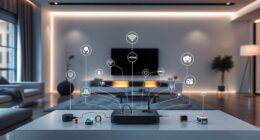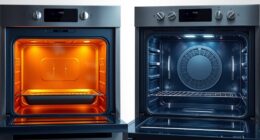In the world of home energy usage, there are certain appliances that may seem harmless when turned off, but still use electricity in the background. These sneaky energy vampires, hiding in our homes, silently suck power even when they seem to be inactive.
Unbeknownst to many, standby mode can be the culprit behind this hidden consumption. From entertainment centers and kitchen appliances to bathroom gadgets and charging stations, various household devices exhibit this peculiar behavior.
In this article, we will delve into the world of appliances that use electricity even when turned off, shedding light on the unexpected costs and providing insights for those seeking mastery over their energy consumption.
Prepare to uncover the hidden culprits and take control of your energy usage.

Key Takeaways
- Standby mode vampires silently drain electricity even when appliances appear to be turned off.
- Smart devices like smart TVs, streaming boxes, and soundbars often stay in standby mode and continue to draw power.
- Some kitchen appliances continue to consume electricity even when turned off or in standby mode.
- The bathroom is another area where hidden energy consumption can occur.
Standby Mode Vampires
Standby mode vampires are a significant source of energy consumption for households, persistently draining electricity even when appliances appear to be turned off. These energy vampires lurk in our homes, silently sucking power and increasing our energy bills.
One common area where standby mode vampires thrive is the entertainment center. Devices like televisions, gaming consoles, and DVD players continue to consume power even when in standby mode. This can lead to a considerable amount of wasted energy and unnecessary costs.
Another area where standby mode vampires can be found is the bedroom, with electronic devices such as alarm clocks, chargers, and televisions silently consuming electricity throughout the day.
By identifying and addressing these power drains, households can significantly reduce energy consumption and save money.

Now, let’s delve into some of the entertainment center culprits and explore how they contribute to standby mode vampire energy consumption.
Entertainment Center Culprits
Devices in the entertainment center are often responsible for consuming electricity even when they appear to be turned off. One common culprit is smart devices, such as smart TVs, streaming boxes, and soundbars. These devices often stay in a standby mode, ready to respond to voice commands or remote control signals. While in standby mode, they continue to draw power, albeit at a lower level compared to when they are actively being used.
Additionally, gaming consoles, such as PlayStation and Xbox, can also be significant energy consumers. Even when turned off, these consoles may still run background processes, download updates, or remain connected to the internet.
It is important for users to be aware of these energy vampires and consider unplugging them when not in use to reduce unnecessary electricity consumption.

Kitchen Appliances That Surprise
When it comes to kitchen appliances, there are some surprising culprits that contribute to phantom power usage. These appliances continue to consume electricity even when they are turned off or in standby mode.
To reduce hidden electricity consumption, it is important to be aware of energy-saving alternatives and make informed choices about the appliances we use in our kitchens.
Phantom Power Usage
Phantom power usage in kitchen appliances can be surprising, as they continue to consume electricity even when switched off. This phenomenon occurs due to the standby mode of these appliances, which allows them to quickly respond to commands from smart home automation systems. While this feature offers convenience, it also leads to unnecessary power consumption.
To minimize phantom power usage in kitchen appliances, it is important to adopt power-saving tips. For example, using power strips with built-in timers can automatically cut off power supply to appliances during periods of inactivity. Additionally, manually unplugging appliances when not in use can also help reduce phantom power usage.

Energy-Saving Alternatives
Kitchen appliances that continue to consume electricity even when turned off can be replaced with energy-saving alternatives.
One such alternative is the use of smart home automation technology. Smart appliances are equipped with sensors and timers that allow users to schedule their operation and monitor their energy consumption. By controlling the power usage of these appliances remotely, individuals can ensure that they are not wasting electricity when not in use.
Additionally, energy-efficient appliances are another option for reducing energy consumption in the kitchen. These appliances are designed to use less electricity while still providing the same level of performance. They often come with energy-saving features such as automatic shut-off and power management modes.
Hidden Electricity Consumption
Many kitchen appliances continue to consume electricity even when they are not in use. This hidden electricity consumption can contribute to high energy bills and unnecessary environmental impact. To help you identify and address these hidden power drains, here are some examples of kitchen appliances that may surprise you:

- Refrigerators: The motor and control systems of refrigerators often run continuously, even when the door is closed.
- Coffee makers: Coffee makers with built-in timers or warming plates can consume electricity when not actively brewing.
- Dishwashers: Some dishwashers have features like heated drying or pre-wash cycles that consume electricity even when not in use.
- Microwaves: Microwaves with digital clocks or standby modes can continue to draw power when not being used.
To mitigate these hidden power drains, consider energy efficient solutions such as purchasing appliances with low standby power consumption, utilizing power strips, and unplugging appliances when not in use.
Sneaky Bathroom Gadgets
When it comes to energy consumption, the bathroom might not be the first place that comes to mind. However, there are several sneaky gadgets in this room that can silently drain electricity even when turned off.
These hidden energy vampires, known as phantom power consumers, can include devices such as electric toothbrush chargers, heated towel racks, and even bathroom scales.
It is important to be aware of these culprits and unplug them when not in use to minimize unnecessary energy waste.

Hidden Energy Vampires
Bathroom gadgets such as hair dryers and electric toothbrush chargers are among the hidden energy vampires that continue to consume electricity even when turned off. These devices are designed to remain on standby mode in order to provide convenience and quick access to power. However, this standby power consumption can add up over time and contribute to unnecessary energy waste.
To address this issue, here are some energy efficient solutions for reducing standby power in bathroom gadgets:
- Unplug the device when not in use
- Use smart power strips to cut off power completely
- Invest in energy-efficient models with low standby power consumption
- Utilize timers or motion sensors to automatically turn off devices
Phantom Power Consumption
Phantom power consumption remains a concern with certain bathroom gadgets, despite being turned off. These sneaky devices, such as smart home devices, continue to use electricity even when not in use, resulting in unnecessary energy waste and higher electricity bills. To help you identify and address this issue, here are some common bathroom gadgets that may contribute to phantom power consumption:
| Bathroom Gadgets | Phantom Power Consumption |
|---|---|
| Electric toothbrush | Continuously charging the battery |
| Electric shaver | Keeping the charging dock powered |
| Hairdryer | Standby mode while plugged in |
To reduce phantom power consumption, consider implementing power-saving techniques such as unplugging devices when not in use, using smart power strips to cut off power completely, or opting for energy-efficient models. By being mindful of phantom power consumption in your bathroom, you can save energy and reduce your carbon footprint.

The Hidden Costs of Charging Stations
Charging stations incur hidden costs due to the continuous consumption of electricity, even when not in use. This constant energy usage can lead to significant financial and environmental impacts. To address this issue, it is crucial to explore energy-efficient charging options and strategies for reducing standby power.
Consider the following:
- Smart charging stations: These devices automatically adjust the charging rate based on the battery’s needs, minimizing energy waste.
- Power management systems: Implementing intelligent systems that regulate the flow of electricity to charging stations can optimize energy consumption.
- Timer-based charging: By setting specific charging times, unnecessary energy usage during idle periods can be avoided.
- Occupancy sensors: Installing sensors that detect when a charging station is in use allows for more targeted energy management.
Lighting Fixtures That Keep Drawing Power
Lighting fixtures continue to consume electricity even when switched off, contributing to unnecessary energy usage and potential financial waste. This hidden power usage occurs because many lighting fixtures are designed with built-in power transformers or other components that draw a small amount of electricity even when not in use. To help readers understand the impact of this hidden power usage, consider the following table:
| Lighting Fixture | Power Usage When Switched Off |
|---|---|
| Traditional Bulb | 0.5 – 2.5 watts |
| LED Bulb | 0 – 0.5 watts |
| Halogen Bulb | 0.5 – 1.5 watts |
To reduce this unnecessary energy consumption, it is recommended to replace traditional bulbs with more energy-efficient options such as LED bulbs. LED bulbs not only consume less power when switched off but also provide significant energy savings when in use. By making these simple changes, consumers can reduce their hidden power usage and contribute to a more sustainable environment. Now, let’s move on to discussing home office energy thieves.

Home Office Energy Thieves
Many electronic devices in home offices continue to draw power even when they are turned off, contributing to unnecessary energy usage and potential financial waste. To prevent this home office power drain, it is important to be aware of the culprits and take necessary steps to mitigate their energy consumption.
Here are some common energy thieves found in home offices:
- Computers: Enable power-saving settings or use sleep mode when not in use.
- Printers: Unplug when not in use or utilize power strips with on/off switches.
- Chargers: Unplug chargers when devices are fully charged.
- Standby mode: Avoid using standby mode for devices and instead turn them off completely.
To combat this issue, investing in energy efficient office equipment, such as ENERGY STAR certified devices, can significantly reduce energy consumption in home offices while maintaining productivity.
HVAC Systems That Don’t Fully Power Down
One common issue that contributes to unnecessary energy usage in home offices is the continuous operation of HVAC systems, which often don’t fully power down even when turned off. HVAC system inefficiencies can lead to significant energy waste and increased utility bills.

Traditional HVAC systems may continue to draw power due to standby modes, which maintain the system’s readiness to quickly resume operation. Additionally, outdated systems may lack energy-saving features and fail to optimize energy usage.
However, energy-saving HVAC technologies are available to address these inefficiencies. These technologies include programmable thermostats, which allow users to set specific temperature settings for different times of the day, and smart HVAC systems that use sensors and data analysis to optimize energy consumption.
Miscellaneous Culprits Around the House
Several common household appliances continue to consume electricity even when they are turned off. These hidden power drains can contribute to unexpected energy usage and higher electricity bills. Here are some miscellaneous culprits around the house that you should be aware of:
- Standby power: Many devices, such as televisions, gaming consoles, and computer monitors, go into standby mode when turned off. They still draw power to maintain functions like remote control readiness or clock displays.
- Chargers: Even when not actively charging a device, chargers for smartphones, tablets, and laptops continue to draw power if left plugged in.
- Appliances with digital displays: Appliances like microwave ovens, coffee makers, and even some refrigerators use electricity to power their digital displays and maintain internal functions.
- Power strips: Power strips that are left plugged in, even with the switch turned off, can still consume small amounts of electricity.
Frequently Asked Questions
How Can I Prevent My Appliances From Using Electricity When They Are Turned Off?
To prevent appliances from using electricity when turned off, consider using smart power strips that cut off power to devices in standby mode. Additionally, enabling energy-saving standby mode on appliances can reduce their power consumption when not in use.

Are All Appliances in Standby Mode Considered Energy Vampires?
Not all appliances in standby mode are considered energy vampires. While some appliances consume minimal energy in this state, others draw significant power. Reducing standby power consumption is crucial for overall energy savings.
Are There Any Kitchen Appliances That Use Electricity Even When They Are Not in Use?
Power saving tips for kitchen appliances are crucial in reducing the impact of phantom energy on electricity consumption. Certain kitchen appliances, even when turned off, still use electricity, contributing to unnecessary energy wastage.
What Are Some Examples of Sneaky Bathroom Gadgets That Continue to Draw Power?
Sneaky bathroom gadgets refer to devices that continue to draw power even when turned off. Examples include electric toothbrush chargers, heated towel racks, and bathroom scales. To reduce electricity usage, unplug these gadgets when not in use.
Can the Hidden Costs of Charging Stations Significantly Impact My Electricity Bill?
The hidden costs of electric vehicles can have a significant impact on your electricity bill. Charging stations, while convenient, can put strain on the power grid and result in higher energy consumption and costs.

Conclusion
In conclusion, understanding which appliances continue to consume electricity when turned off can help minimize energy waste and reduce electricity bills. By identifying and addressing the standby mode vampires, individuals can take proactive steps towards energy efficiency. This includes kitchen appliances, bathroom gadgets, charging stations, lighting fixtures, home office equipment, HVAC systems, and miscellaneous culprits around the house.
As the saying goes, "Knowledge is power," and in this case, it can also save power.










